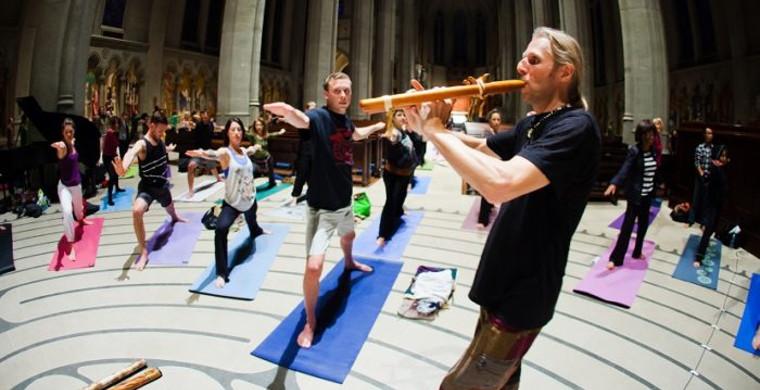Virginia Seminary Labyrinth to Commemorate 1880s Black Chapel
By Jeff Walton
https://juicyecumenism.com/2017/08/17/labyrinth/
August 17, 2017
An Episcopal Church seminary seeks to commemorate African Americans which once worshiped on its Alexandria, Virginia campus by constructing a late 20th-century innovation that would have been unfamiliar to them: a modern labyrinth.
The Virginia Theological Seminary (VTS) classes of 2009 and 2017 jointly gifted the installation after culling through ideas which arose in a class survey. An initial idea was to construct a Stations of the Cross to commemorate St. Cyprian's Chapel, built in the early 1880s at the then-segregated VTS for the local African American community following the Civil War and later moved in the 1920s, or to build a permanent labyrinth.
"There was really strong sentiment in favor of commemorating the St. Cyprian's Chapel," said organizer Serina Sides in an article about the installation featured in the summer 2017 edition of the VTS journal News from the Hill. "Race relations, racial justice, racial reconciliation -- all have been a point of discussion ever since we arrived on campus."
The walls of the 1881 Chapel Garden were not stable enough to support additional work, so members of the class were "inspired" to combine the ideas and name the labyrinth in honor of the chapel.
"It is exciting that the Seminary was able to commemorate the African American community in this way," Sides added, apparently unconcerned about appropriating the chapel name for a completely unrelated project.
The idea of a labyrinth isn't brand new at VTS, but it isn't old, either.
"For the 17 years I've been here, there has been talk about having a labyrinth," said the Rev. Barney Hawkins, vice president of Institutional Advancement at VTS.
Commemorating a 19th-century African American church with a labyrinth has all the historical resonance of marking the site of the pilgrim landing with a new Apple store. Labyrinths are far-removed from the historic religious experience of black America, and are more commonly associated with upper middle class middle-aged white people doing yoga to pan flute music.
"We used the 'Vision Quest' design, which is a modern design that I created," explained designer David Tolzmann in News from the Hill. "There is a lot of demand for labyrinths because of the stories of the people who use them and the value people find in having them. These go back thousands and thousands of years."
Well, sort of. The modern "labyrinth movement" traces its origins to the late 1980s at Grace Cathedral in San Francisco. While the Chartres Cathedral labyrinth constructed in the late 12th century is cited as an inspiration for the modern movement, Jesus Christ doesn't figure prominently. Instead, proponents of labyrinths see them as "making space for the inner journey" in the words of Judith Tripp of Veriditas, which promotes programs centered on the labyrinth.
The Veriditas web site notes eastern religions, the new age movement and the 1987 "Harmonic Convergence" as context for the emergence of the labyrinth movement. African American church history -- and Jesus Christ -- is not mentioned. Labyrinths seem to play no role in contemporary black Christianity, either.
In a relatively short span of time, labyrinths have spread far beyond San Francisco. The Episcopal Washington National Cathedral has one; historic Christ Church in Old Town Alexandria not far from Virginia Seminary also constructed a labyrinth. Progressive Episcopal parishes are most likely to host them. Despite the inspiration of Chartres Cathedral, the trend has not been as widely embraced in Roman Catholicism or other historic, liturgical Christian traditions.
The labyrinth concept may not be directly objectionable. Its problems lie more in the vague promise of spiritual awakening found more often in eastern mysticism and untethered from the person of Jesus Christ. In an Episcopal Church where the "vision quest" and journey is always in fashion and increasing signs of external religiosity have substituted for core Christian doctrine, the process of seeking is in, the act of finding truth is out.
Interestingly, the VTS marker says nothing about the chapel (and now labyrinth) namesake, St. Cyprian, the 3rd century bishop of Carthage and early Christian writer. An opponent of the Novatianist heresy, he advocated a policy under which former idolaters could be once again admitted to communion with the church following public penance.
It's a lost opportunity. An installation named for St. Cyprian could point to Christian martyrs: Cyprian was martyred at Carthage under Emperor Valerian's persecution.














